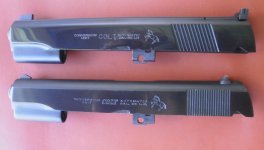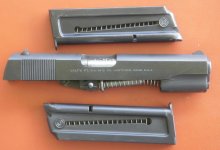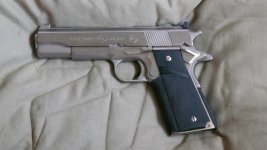This is a draft of a future article which will probably appear in Dillon's Blue Press catalog/magazine. It's here for comments/corrections. Bear in mind that both the photo and the text are copyrighted, but members here are welcome to download this info for personal reference.
John
Colt's .45 to .22 Conversion Units

It was not long after the United States adopted John Browning’s Model of 1911 pistol that the quest for a similar pistol shooting inexpensive .22 rimfire ammunition began. The thought was that this type of pistol would make for much more economical training. In 1913, Springfield Armory and Colt’s Patent Firearms Manufacturing Company worked on developing what they hoped would be a workable pistol. After much experimenting, it was finally determined by the military in 1927 that the idea was impractical and the project was dropped. The .22 Long Rifle cartridge was way too underpowered to work properly within the M1911 envelope. By the same token, Colt’s remained interested in the idea. In 1930, the company solicited input from the public on the desirability of a .22 training pistol along the lines of the Government Model pistol. The response was quite positive.
In 1931, Colt’s put the Ace pistol on the market. It had the same outward dimensions as the .45 Government model, but utilized a drastically lightened slide and a heavy barrel chambered for the .22 Long Rifle cartridge. The frame was the same as the Government Model. The action was straight blowback, with only the mass of the slide and the resistance of the recoil and hammer springs to keep the breech closed during firing. The magazine held 10 rounds, and the rear sight was the “Improved Ace Adjustable Target Sight” which was marginally larger than a standard fixed sight. The right side of the slide read “COLT ACE .22 LONG RIFLE.” About 11,000 of them were produced.
The U.S. Army was interested enough to purchase 206 of these pistols through 1936. However, because the .22 cartridges of that era lacked enough power to consistently and reliably function the slide, they devoted no further attention to the idea. In 1941, the Ace pistol was discontinued.
In 1937, Colt’s brought out its improved “Service Model Ace.” This pistol’s distinguishing feature was a floating chamber arrangement invented by David Marshall Williams, later to be known as “Carbine Williams” when he invented the short-stroke piston used on the U.S. M1 Carbine of World War II fame. The floating chamber allowed combustion gases to push back that sliding internal chamber with some energy, enough to give the slide a forceful kick and in the process provide a modest amount of felt recoil. The serial numbers on these pistols were prefixed by “SM.” Externally it was similar to the Ace, but the slide was marked “COLT SERVICE MODEL ACE .22 LONG RIFLE.” 13,803 were produced through 1945, most of which were purchased by the U.S. Army. Many of Army pistols were marked “US PROPERTY.” Initially these pistols were blued, but at about serial number SM4840, Parkerizing became the standard finish.
In 1938 Colt’s marketed its first conversion unit, which was in reality mostly the top half of a Service Model Ace. It was designed to allow owners of centerfire pistols the capability of shooting .22s using the existing frames of their pistols. The unit consisted of a slide marked “Service Model Ace,” a barrel with the floating chamber, an ejector, slide lock, barrel bushing, recoil spring, 10-round magazine, box and instructions. These early conversion slides had Stevens adjustable rear sights, except for a small run with fixed sights, apparently made for the military 1938-1941. Also in 1938, a kit to convert a .22 pistol to .45 was produced and marketed. Production ceased on all conversion units in 1942. The .22 kit was re-introduced in 1947, but the .45 kit was not. Conversion kit slides were marked “CONVERSION UNIT”, while the slides of the Service Model Ace pistols were not. Pre-war conversion units were serialized in front of the rear sight, from U1 to U2000. Post-war units were numbered from U2001 to U2670, and then were produced with no serial numbers. Most of these will be found with Coltmaster (rather than Stevens) rear sights, identical to those found on Colt Woodsman Match Target .22 pistols and Officer’s Model Special revolvers of that era. A few Service Model Ace pistols were made from parts produced during the war, but these were discontinued in 1949. In 1953, the Accro adjustable rear sight and slanted slide serrations were phased in on the conversion units.
In 1978, Colt’s resurrected the Service Model Ace pistol, and continued manufacture of it until 1982. These post-war pistols with Accro rear sights are not considered as valuable as their pre-war predecessors. There were about 3,000 fixed sight conversion units with vertical slide serrations made in the 1981-1983 time period.
A Colt Ace II conversion unit has been made in recent years. It has a very light aluminum slide and is designed to work with Series 80 pistols that have the firing pin safety lever and plunger. If the firing pin safety lever is removed from such pistols (your decision), the earlier conversion units will usually work.
A note is in order here on the slide lock levers furnished with the floating chamber units. These will be marked with the number “2.” They should always be used when .22s are fired. While a standard .45 or .38 Super slide lock will work, these will eventually damage the nub on the .22 magazine follower that activates the slide lock on firing the last round. A replacement follower or magazine can be pricey.
Those units with the floating chamber will foul those chambers very quickly with standard velocity lead bullet ammunition. I personally have had much better results with high speed ammo using plated bullets. Remington Golden Bullets seem to work pretty well, and CCI Stingers (hyper-speed with a slightly longer case) do best in my experience. The bullet needs to be well down the barrel before the floating chamber starts back – otherwise sheared lead can muck things up and require vigorous scrubbing of the floating chamber and its seat in the barrel with a brass bristle brush. Never use steel wool to clean these components; it can mess with critical dimensions and make matters far worse.
Given the proper selection of ammo and correct lubrication / maintenance, the Colt conversion units do work quite well, and are an economical alternative to firing expensive .45 ammunition. These are classic devices that are well worth having. Pre-war units in particular have seen steady demand by collectors and ever-increasing prices. As always, an original box and papers are quite desirable. I get a great deal of satisfaction firing mine knowing that I’m saving money over .45 ammo with every pull of the trigger!
(c) 2016 JLM
John
Colt's .45 to .22 Conversion Units

It was not long after the United States adopted John Browning’s Model of 1911 pistol that the quest for a similar pistol shooting inexpensive .22 rimfire ammunition began. The thought was that this type of pistol would make for much more economical training. In 1913, Springfield Armory and Colt’s Patent Firearms Manufacturing Company worked on developing what they hoped would be a workable pistol. After much experimenting, it was finally determined by the military in 1927 that the idea was impractical and the project was dropped. The .22 Long Rifle cartridge was way too underpowered to work properly within the M1911 envelope. By the same token, Colt’s remained interested in the idea. In 1930, the company solicited input from the public on the desirability of a .22 training pistol along the lines of the Government Model pistol. The response was quite positive.
In 1931, Colt’s put the Ace pistol on the market. It had the same outward dimensions as the .45 Government model, but utilized a drastically lightened slide and a heavy barrel chambered for the .22 Long Rifle cartridge. The frame was the same as the Government Model. The action was straight blowback, with only the mass of the slide and the resistance of the recoil and hammer springs to keep the breech closed during firing. The magazine held 10 rounds, and the rear sight was the “Improved Ace Adjustable Target Sight” which was marginally larger than a standard fixed sight. The right side of the slide read “COLT ACE .22 LONG RIFLE.” About 11,000 of them were produced.
The U.S. Army was interested enough to purchase 206 of these pistols through 1936. However, because the .22 cartridges of that era lacked enough power to consistently and reliably function the slide, they devoted no further attention to the idea. In 1941, the Ace pistol was discontinued.
In 1937, Colt’s brought out its improved “Service Model Ace.” This pistol’s distinguishing feature was a floating chamber arrangement invented by David Marshall Williams, later to be known as “Carbine Williams” when he invented the short-stroke piston used on the U.S. M1 Carbine of World War II fame. The floating chamber allowed combustion gases to push back that sliding internal chamber with some energy, enough to give the slide a forceful kick and in the process provide a modest amount of felt recoil. The serial numbers on these pistols were prefixed by “SM.” Externally it was similar to the Ace, but the slide was marked “COLT SERVICE MODEL ACE .22 LONG RIFLE.” 13,803 were produced through 1945, most of which were purchased by the U.S. Army. Many of Army pistols were marked “US PROPERTY.” Initially these pistols were blued, but at about serial number SM4840, Parkerizing became the standard finish.
In 1938 Colt’s marketed its first conversion unit, which was in reality mostly the top half of a Service Model Ace. It was designed to allow owners of centerfire pistols the capability of shooting .22s using the existing frames of their pistols. The unit consisted of a slide marked “Service Model Ace,” a barrel with the floating chamber, an ejector, slide lock, barrel bushing, recoil spring, 10-round magazine, box and instructions. These early conversion slides had Stevens adjustable rear sights, except for a small run with fixed sights, apparently made for the military 1938-1941. Also in 1938, a kit to convert a .22 pistol to .45 was produced and marketed. Production ceased on all conversion units in 1942. The .22 kit was re-introduced in 1947, but the .45 kit was not. Conversion kit slides were marked “CONVERSION UNIT”, while the slides of the Service Model Ace pistols were not. Pre-war conversion units were serialized in front of the rear sight, from U1 to U2000. Post-war units were numbered from U2001 to U2670, and then were produced with no serial numbers. Most of these will be found with Coltmaster (rather than Stevens) rear sights, identical to those found on Colt Woodsman Match Target .22 pistols and Officer’s Model Special revolvers of that era. A few Service Model Ace pistols were made from parts produced during the war, but these were discontinued in 1949. In 1953, the Accro adjustable rear sight and slanted slide serrations were phased in on the conversion units.
In 1978, Colt’s resurrected the Service Model Ace pistol, and continued manufacture of it until 1982. These post-war pistols with Accro rear sights are not considered as valuable as their pre-war predecessors. There were about 3,000 fixed sight conversion units with vertical slide serrations made in the 1981-1983 time period.
A Colt Ace II conversion unit has been made in recent years. It has a very light aluminum slide and is designed to work with Series 80 pistols that have the firing pin safety lever and plunger. If the firing pin safety lever is removed from such pistols (your decision), the earlier conversion units will usually work.
A note is in order here on the slide lock levers furnished with the floating chamber units. These will be marked with the number “2.” They should always be used when .22s are fired. While a standard .45 or .38 Super slide lock will work, these will eventually damage the nub on the .22 magazine follower that activates the slide lock on firing the last round. A replacement follower or magazine can be pricey.
Those units with the floating chamber will foul those chambers very quickly with standard velocity lead bullet ammunition. I personally have had much better results with high speed ammo using plated bullets. Remington Golden Bullets seem to work pretty well, and CCI Stingers (hyper-speed with a slightly longer case) do best in my experience. The bullet needs to be well down the barrel before the floating chamber starts back – otherwise sheared lead can muck things up and require vigorous scrubbing of the floating chamber and its seat in the barrel with a brass bristle brush. Never use steel wool to clean these components; it can mess with critical dimensions and make matters far worse.
Given the proper selection of ammo and correct lubrication / maintenance, the Colt conversion units do work quite well, and are an economical alternative to firing expensive .45 ammunition. These are classic devices that are well worth having. Pre-war units in particular have seen steady demand by collectors and ever-increasing prices. As always, an original box and papers are quite desirable. I get a great deal of satisfaction firing mine knowing that I’m saving money over .45 ammo with every pull of the trigger!
(c) 2016 JLM
Last edited:





